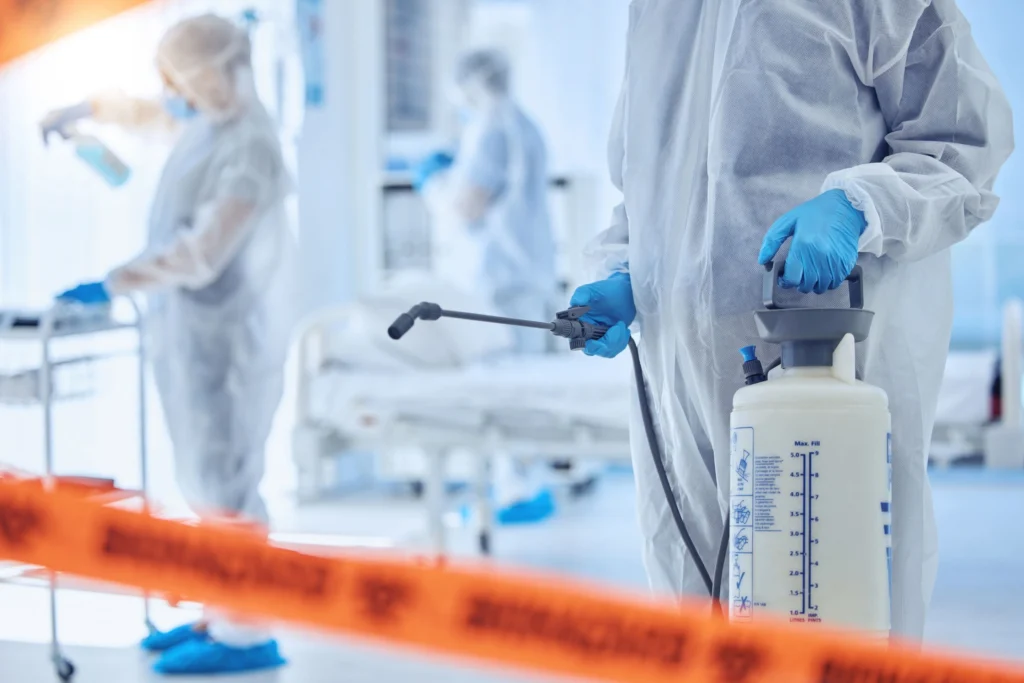INTRODUCTION ISO 14644 CLEANROOM COMPLIANCE: FOCUS ON CLEANING PROTOCOLS & CONTAMINATION CONTROL
To provide participants with a thorough understanding of ISO 14644 cleanroom standards and to equip them with the practical knowledge and skills to execute effective cleaning and disinfection procedures.
LEARNING OUTCOMES
By the end of the session, the participants will be able to:
- Understand the core principles of contamination control, the structure of ISO 14644, and the science behind cleanroom cleaning.
WHO SHOULD ATTEND
Cleanroom operators, cleaning staff, technicians, quality assurance personnel, and new supervisors.
METHODOLOGY
This program ensures that attendees leave not just knowing what the standard says, but how to implement it correctly and effectively in their daily roles, significantly reducing contamination risk.
COURSE OUTLINE
Day 1. 9.00am to 12.00pm
Pre-Test
Introduction
- Course objectives & overview.
- Participant introductions and expectations.
- The importance of contamination control (safety, quality, yield).
Module 1: ISO 14644-1 & -2 Fundamentals
- ISO 14644-1: Classification of Air Cleanliness:
- – What are particle counts?
- – The 9 ISO classes (ISO 5, ISO 7, ISO 8).
- – How classification testing is performed.
- ISO 14644-2: Monitoring & Compliance:
- – Required monitoring frequency.
- – Alert and action levels.
- – Response to out-of-spec data.
Module 2: Sources of Contamination & Cleanroom Behaviour
- Sources: People (~80%), processes, equipment, facilities.
- Behaviour:
- Proper gowning procedures (demonstration of steps for the relevant class).
- Movement (slow, deliberate, no sudden motions).
- Hygiene practices outside the cleanroom.
- Prohibited items (cosmetics, jewellery, paper).
1.00pm to 5.00pm
Module 3: The Science of Cleaning & Disinfection
- Definitions: Cleaning (remove dirt), Disinfection (kill microorganisms).
- Chemistry Basics:
- Types of agents: Sporicidal, bactericidal, fungicidal.
- How disinfectants work (contact time, efficacy).
- The concept of “rotation” or “tiering” to prevent resistance.
- Importance of pH (acidic vs. alkaline cleaners).
Module 4: Cleaning Materials & Tools
- Non-Shedding Materials: Why they are critical.
- Tool Overview:
- Wipers: Knit polyester, micro denier, non-woven. Low-lint properties. Usage for different tasks (spills vs. critical surfaces).
- Mops: Bucket systems (single-bucket vs. twin-bucket). Microfiber mop heads.
- Solutions: Pre-mixed vs. concentrated. Proper dilution practices.
- Other Tools: Vacuum cleaners with HEPA/ULPA filters, squeegees, dedicated carts.
Day 2 – 9.00am to 12.00pm
Module 5: Developing Cleaning Protocols (SOPs)
- Elements of a Good Cleaning SOP:
- Frequency (daily, weekly, monthly).
- Scope (which rooms, areas).
- Required materials and tools.
- Step-by-Step Instructions: The “how-to”.
- Critical Parameters: Contact time, dilution ratios.
- Safety precautions (PPE, SDS).
- Documentation and verification.
Module 6: Cleaning Methods & Techniques
- The Four Golden Rules:
- Clean from cleanest to dirtiest area.
- Clean from top to bottom (ceiling to floor).
- Overlap wipe strokes.
- Use the correct “S” pattern or unidirectional wiping.
- Practical Techniques:
- Wiping: Folded wiper method (4 sides, 8 sides).
- Mopping: The figure-8 method in a twin-bucket system.
- Surface Spraying: “Spray and wipe” vs. “spray wipe”.
- Vacuuming: Correct slow, overlapping passes.
1.00pm to 5.00pm
Module 7: Validation & Monitoring of Cleanliness
- How do we know it’s clean?
- ISO 14644-3 & -5: Test methods.
- Direct Monitoring: Particle counters, viable air samplers (settle plates, active air samplers).
- Indirect Monitoring:
- ATP Bioluminescence: Demo of swabbing and reading results. Practical, rapid feedback.
- Surface Sampling (contact plates).
- Trend analysis and investigating excursions.
Module 8: Case Studies & Problem Solving
- Scenario 1: Recurring high particle counts – how to investigate?
- Scenario 2: An action level excursion on a critical surface.
- Scenario 3: Choosing a new disinfectant.
- Group discussion on solutions.
Post Test


